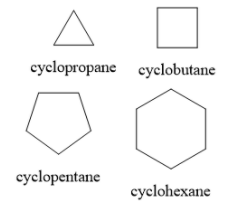Answer
323.5k+ views
Hint: According to Baeyer's strain theory, the stability of cycloalkanes is dependent on the variation between the bond angles present in the ring system and the normal tetrahedral bond angle. Greater is this difference, greater is the strain on the ring system and lesser is the stability of the ring. To find out the most stable cyclic compound, determine the angle strain for each cycloalkane.
Complete answer:
Baeyer’s strain theory was proposed by the German chemist Dr. Bayer for the determination of stability order in rings.
The angle strain is the magnitude of the difference between the desired carbon-carbon bond angle and the actual carbon-carbon bond angle. Closer is the actual carbon-carbon bond angle to the desired carbon-carbon bond angle, lower is the angle strain and greater is the stability of cycloalkane.
Cycloalkanes are hydrocarbons containing carbon and hydrogen atoms. They contain all single bonds. They contain one (or more) ring of carbon atoms. Cyclopropane, cyclobutane, cyclopentane and cyclohexane contain 3,4,5, and 6 carbon atoms respectively. The structures of cycloalkanes are shown below:

The decreasing order of the stabilities of cycloalkanes is cyclopentane > cyclohexane > cyclobutane > cyclopropane.
For cyclopentane, the angle strain is lowest. Hence, among the given cycloalkanes, cyclopentane is the most stable cycloalkane.
Hence, the option C ) cyclopentane is the correct option.
Note: Greater is the difference between the desired carbon-carbon bond angle and the actual carbon-carbon bond angle, greater is the angle strain and lower is the stability of the cycloalkane.
Complete answer:
Baeyer’s strain theory was proposed by the German chemist Dr. Bayer for the determination of stability order in rings.
The angle strain is the magnitude of the difference between the desired carbon-carbon bond angle and the actual carbon-carbon bond angle. Closer is the actual carbon-carbon bond angle to the desired carbon-carbon bond angle, lower is the angle strain and greater is the stability of cycloalkane.
Cycloalkanes are hydrocarbons containing carbon and hydrogen atoms. They contain all single bonds. They contain one (or more) ring of carbon atoms. Cyclopropane, cyclobutane, cyclopentane and cyclohexane contain 3,4,5, and 6 carbon atoms respectively. The structures of cycloalkanes are shown below:

| Cycloalkane | Desired carbon-carbon bond angle | actual carbon-carbon bond angle | Angle strain |
| Cyclopropane | \[109^\circ \] | \[ 60 ^\circ \] | \[ 49 ^\circ \] |
| Cyclobutane | \[109^\circ \] | \[ 90^\circ \] | \[ 19 ^\circ \] |
| Cyclopentane | \[109^\circ \] | \[ 108^\circ \] | \[ 1 ^\circ \] |
| Cyclohexane | \[109^\circ \] | \[ 120^\circ \] | \[ 11 ^\circ \] |
The decreasing order of the stabilities of cycloalkanes is cyclopentane > cyclohexane > cyclobutane > cyclopropane.
For cyclopentane, the angle strain is lowest. Hence, among the given cycloalkanes, cyclopentane is the most stable cycloalkane.
Hence, the option C ) cyclopentane is the correct option.
Note: Greater is the difference between the desired carbon-carbon bond angle and the actual carbon-carbon bond angle, greater is the angle strain and lower is the stability of the cycloalkane.
Recently Updated Pages
Basicity of sulphurous acid and sulphuric acid are

Three beakers labelled as A B and C each containing 25 mL of water were taken A small amount of NaOH anhydrous CuSO4 and NaCl were added to the beakers A B and C respectively It was observed that there was an increase in the temperature of the solutions contained in beakers A and B whereas in case of beaker C the temperature of the solution falls Which one of the following statements isarecorrect i In beakers A and B exothermic process has occurred ii In beakers A and B endothermic process has occurred iii In beaker C exothermic process has occurred iv In beaker C endothermic process has occurred

What is the stopping potential when the metal with class 12 physics JEE_Main

The momentum of a photon is 2 times 10 16gm cmsec Its class 12 physics JEE_Main

How do you arrange NH4 + BF3 H2O C2H2 in increasing class 11 chemistry CBSE

Is H mCT and q mCT the same thing If so which is more class 11 chemistry CBSE

Trending doubts
Difference between Prokaryotic cell and Eukaryotic class 11 biology CBSE

Fill the blanks with the suitable prepositions 1 The class 9 english CBSE

Two charges are placed at a certain distance apart class 12 physics CBSE

Difference Between Plant Cell and Animal Cell

What organs are located on the left side of your body class 11 biology CBSE

Change the following sentences into negative and interrogative class 10 english CBSE

The planet nearest to earth is A Mercury B Venus C class 6 social science CBSE

The Equation xxx + 2 is Satisfied when x is Equal to Class 10 Maths

What is BLO What is the full form of BLO class 8 social science CBSE



